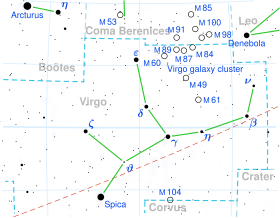Iota Virginis
Iota Virginis (ι Virginis, abbreviated Iota Vir, ι Vir) is a binary star in the constellation of Virgo. Its apparent magnitude is 4.08.[2] Based on its parallax, it is assumed to be relatively nearby, at 71.8 light-years (22.0 parsecs).[1]
Its two components are designated Iota Virginis A (officially named Syrma /ˈsɜːrmə/,[7] the traditional name for the system)[8] and B.
Nomenclature
[edit]ι Virginis (Latinised to Iota Virginis) is the system's Bayer designation. The designations of the two components as Iota Virginis A and B derive from the convention used by the Washington Multiplicity Catalog (WMC) for multiple star systems, and adopted by the International Astronomical Union (IAU).[9]
It bore the traditional name Syrma, derived from the Arabic سرما (تطريز sirmā "train (of a garment)".[10] In 2016, the International Astronomical Union organized a Working Group on Star Names (WGSN)[11][12] to catalogue and standardize proper names for stars. The WGSN approved the name Syrma for Iota Virginis on 12 September 2016 and it is now so included in the List of IAU-approved Star Names.[8] For such names relating to members of multiple star systems, and where a component letter (from e.g. Washington Double Star Catalog) is not explicitly listed, the WGSN says that the name should be understood to be attributed to the brightest component by visual brightness.[13]
In China, 亢宿 (Kàng Xiù), meaning Neck, refers to an asterism consisting of this star, Kappa Virginis, Phi Virginis and Lambda Virginis.[14] Consequently, Iota Virginis itself is known as 亢宿二 (Kàngxiùèr, English: the Second Star of Neck).
Properties
[edit]Iota Virginis is an astrometric binary. The secondary regularly perturbs the primary, causing the latter to wobble around its barycenter.[3] A preliminary orbit with a period of 55 years has been calculated.[3]
Iota Virginis A is a yellow-colored star with a spectral class of F7IV-V. This star has 1.44 times the mass of the Sun,[5] with a projected rotational velocity of 16 km s−1.[3] It is radiating 10 times the luminosity of the Sun from its outer atmosphere at an effective temperature of 6,055 K. The radius is about 2.89 times that of the Sun.[6]
Iota Virginis B has not been directly detected, but based on its mass (0.6 M☉) it may be a main-sequence star or a white dwarf.[3] That star is also responsible for the drifting radial velocity of the primary.[15]
In 2011, it was noticed that the faint K-type main-sequence star HD 125354 had a similar proper motion throughout space, and was likely physically associated.[16] Another 2015 paper supported this hypothesis. The star, which is located 1.2 ly (0.37 pc) away from Iota Virginis, also has a similar distance from the Sun, within the margin of error. It itself is a close binary with another star separated 0.33″ from the main star.[17]
References
[edit]- ^ a b c d e f Vallenari, A.; et al. (Gaia collaboration) (2023). "Gaia Data Release 3. Summary of the content and survey properties". Astronomy and Astrophysics. 674: A1. arXiv:2208.00211. Bibcode:2023A&A...674A...1G. doi:10.1051/0004-6361/202243940. S2CID 244398875. Gaia DR3 record for this source at VizieR.
- ^ a b Gray, R. O.; Napier, M. G.; Winkler, L. I. (2001). "The Physical Basis of Luminosity Classification in the Late A-, F-, and Early G-Type Stars. I. Precise Spectral Types for 372 Stars". The Astronomical Journal. 121 (4): 2148. Bibcode:2001AJ....121.2148G. doi:10.1086/319956.
- ^ a b c d e f g h i Gontcharov, G.A.; Kiyaeva, O.V. (2010). "Photocentric orbits from a direct combination of ground-based astrometry with Hipparcos II. Preliminary orbits for six astrometric binaries". New Astronomy. 15 (3): 324–331. arXiv:1606.08182. Bibcode:2010NewA...15..324G. doi:10.1016/j.newast.2009.09.006. S2CID 119252073.
- ^ a b Mermilliod, J.-C. (1986). "Compilation of Eggen's UBV data, transformed to UBV (unpublished)". Catalogue of Eggen's UBV Data. Bibcode:1986EgUBV........0M.
- ^ a b c Aguilera-Gómez, Claudia; Ramírez, Iván; Chanamé, Julio (2018-06-01). "Lithium abundance patterns of late-F stars: an in-depth analysis of the lithium desert". Astronomy and Astrophysics. 614: A55. arXiv:1803.05922. Bibcode:2018A&A...614A..55A. doi:10.1051/0004-6361/201732209. ISSN 0004-6361. Iota Virginis' database entry at VizieR.
- ^ a b c d e Baines, Ellyn K.; Clark, James H., III; Schmitt, Henrique R.; Stone, Jordan M.; von Braun, Kaspar (2023-12-01). "33 New Stellar Angular Diameters from the NPOI, and Nearly 180 NPOI Diameters as an Ensemble". The Astronomical Journal. 166 (6): 268. Bibcode:2023AJ....166..268B. doi:10.3847/1538-3881/ad08be. ISSN 0004-6256.
{{cite journal}}: CS1 maint: multiple names: authors list (link) - ^ "syrma". Oxford English Dictionary (Online ed.). Oxford University Press. (Subscription or participating institution membership required.)
- ^ a b "Naming Stars". IAU.org. Retrieved 16 December 2017.
- ^ Hessman, F. V.; Dhillon, V. S.; Winget, D. E.; Schreiber, M. R.; Horne, K.; Marsh, T. R.; Guenther, E.; Schwope, A.; Heber, U. (2010). "On the naming convention used for multiple star systems and extrasolar planets". arXiv:1012.0707 [astro-ph.SR].
- ^ Allen, R. H. (1963). Star Names: Their Lore and Meaning (Reprint ed.). New York, NY: Dover Publications Inc. pp. 472. ISBN 0-486-21079-0.
- ^ IAU Working Group on Star Names (WGSN), International Astronomical Union, retrieved 22 May 2016.
- ^ IAU Formally Approves 227 Star Names, International Astronomical Union, retrieved 24 November 2016.
- ^ "Bulletin of the IAU Working Group on Star Names, No. 2" (PDF). Retrieved 16 December 2017.
- ^ (in Chinese) AEEA (Activities of Exhibition and Education in Astronomy) 天文教育資訊網 2006 年 6 月 28 日 Archived 2011-07-16 at the Wayback Machine
- ^ Borgniet, S.; Lagrange, A.-M.; Meunier, N.; Galland, F. (2017). "Extrasolar planets and brown dwarfs around AF-type stars". Astronomy & Astrophysics. 599: A57. arXiv:1608.08257. Bibcode:2017A&A...599A..57B. doi:10.1051/0004-6361/201628805. S2CID 118723455.
- ^ Shaya, Ed J.; Olling, Rob P. (January 2011). "Very Wide Binaries and Other Comoving Stellar Companions: A Bayesian Analysis of the Hipparcos Catalogue". The Astrophysical Journal Supplement. 192 (1): 2. arXiv:1007.0425. Bibcode:2011ApJS..192....2S. doi:10.1088/0067-0049/192/1/2. S2CID 119226823.
- ^ Fuhrmann, K.; Chini, R. (2015). "Multiplicity Among F-Type Stars. II". The Astrophysical Journal. 809 (1): 107. Bibcode:2015ApJ...809..107F. doi:10.1088/0004-637X/809/1/107.

